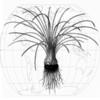| Publication Type: | Journal Article |
| Year of Publication: | 1998 |
| Authors: | F. - S. Meng |
| Journal: | Acta Botanica Sinica |
| Volume: | 40 |
| Issue: | 8 |
| Pagination: | 768 - 774 |
| Date Published: | 1998/// |
| Keywords: | Annalepis, Evolution, Isoetes, Middle Triassic, Origin, Yangtze river valley |
| Abstract: | Specimens of Annalepis have been found from the Middle Triassic Series in the Yangtze River valley and described, including a new species. Annalepis is similar to the living plant, Isoëtes , in many aspects, such as the herb with a corm, more or less clustering sporophylls, presence of a ligule, monolete suture microspores of Aratrisporites -type and trilete megaspores, etc. The similarities of features between the two plants indicate their close affinities and that A . brevicystis might be the ancestry of Isoëtes . Since there is a ligule on the sporophyll of Pleuromeia, the Pleuromeiaceae represented by Pleuromeia could be allied to the Isoëtaceae, and both families should belong to Isoëtales. Isoëtales represents a distinct evolutionary sequence and is inferred as being evolved probably from Palaeozoic Sigillaria . In Mesozoic age, two evolutionary lines are proposed: one as a line from Pleuromeia to Nathorstiana in relation to wood-monopolar rhizophore; the other as a line from Annalenis to Isoëtes related to herb-bipolar corm. Annalepis appeared almost simultaneously in the Yangtze River valley in early Middle Triassic, but the distribution of Annalepis was concentrated from east to west during middle-late Middle Triassic, in relation to the marine regression which occurred cyclically from east to west on the Yangtze Platform during that time. |
| URL: | http://www.scopus.com/inward/record.url?eid=2-s2.0-0032414084&partnerID=40&md5=b6306b3189c6672809b1bab17e2dd168 |
Studies on Annalepis from Middle Triassic along the Yangtze river and its bearing on the origin of Isoëtes
Taxonomic name:
